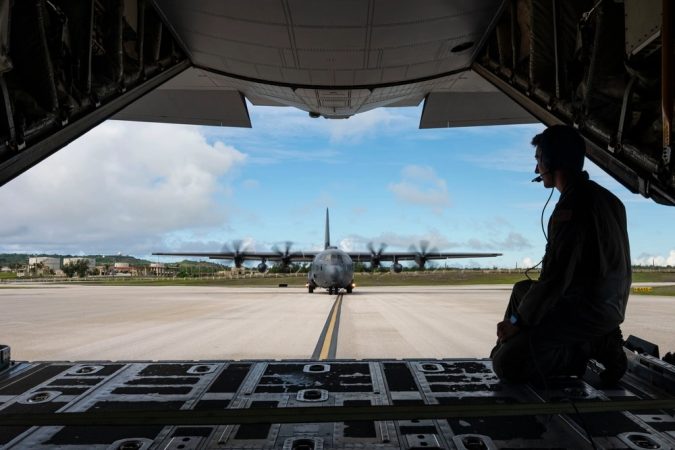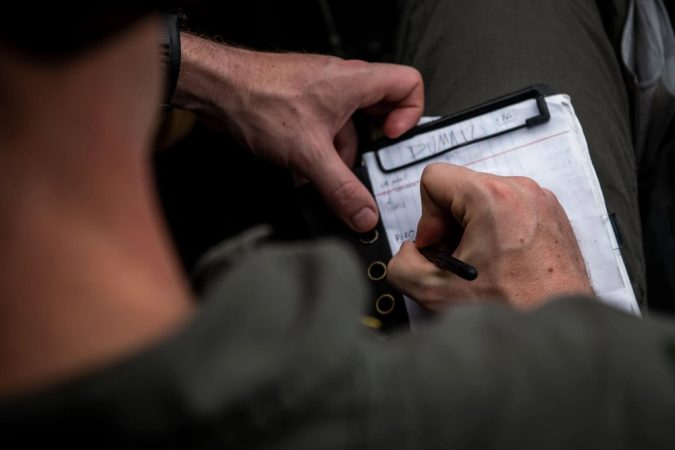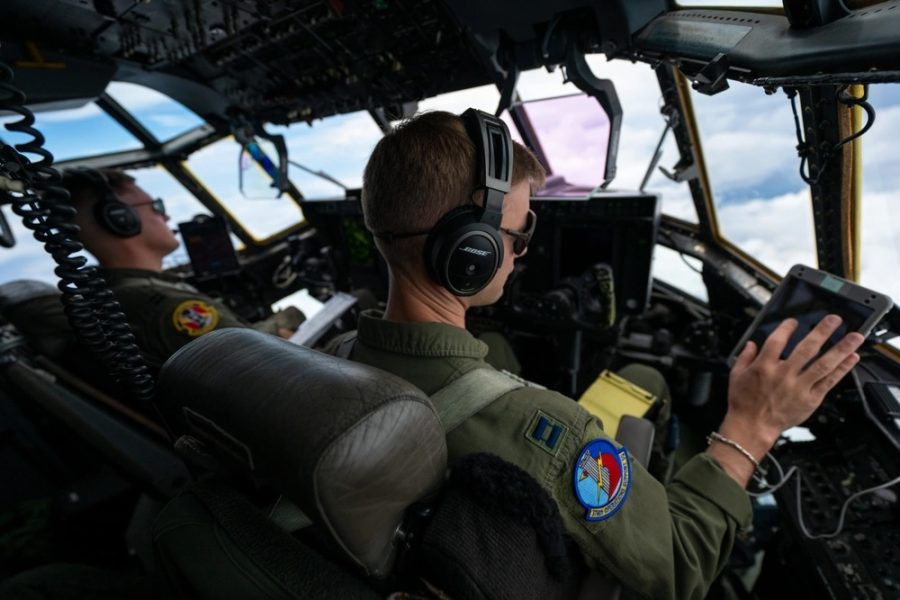ANDERSEN AIR FORCE BASE, Guam—Moving military cargo across an ocean in a hurry is a tough job. Air Force flight crews and planners must juggle diplomatic clearances, airfield conditions, availability of troops and equipment to move pallets, and—perhaps most important—who to talk to when plans change.
Air Force transport and tanker fleets have long struggled to adapt to mid-flight changes, since they rely on relatively short-range radios. That posed a major challenge for troops during Mobility Guardian, Air Mobility Command’s premier training exercise, in 2023, prompting the command to take a closer look.
Two years later, new artificial intelligence software powered by in-flight Wi-Fi kept C-130 transport crews ahead of the curve this summer at a massive Air Force war game in the Pacific.
“Connectivity gives you the ability to stay flexible and adaptive in your logistics chain,” said Lt. Col. James Vanderneck, who ran a detachment of C-130s flying airlift missions between Guam and nearby islands during the event, known as the Department-Level Exercise. AI enhances that flexibility by changing how Airmen report and document information up and down the chain of command, he said.
Some 12,000 Airmen and Guardians came together at the event that began July 8 to practice air combat, airlift, aerial refueling, aeromedical evacuation, and other missions alongside other U.S. armed forces and America’s foreign allies and partners, as they would if the U.S. goes to war with China.

In a region defined by long-haul flights, the fleet of six C-130s from Little Rock Air Force Base, Ark., and Dyess AFB, Texas, was tasked with a more tactical mission: moving small amounts of cargo over short distances. To make sure equipment got from Point A to Point B, Hercules crews had the help of the Airlift Tanker Open Mission Systems (ATOMS) kit, a backpack-sized device that acts as a mobile hotspot for secure and commercial Wi-Fi in flight.
In-flight Wi-Fi helps with even the shorter hops, as it makes changing plans easier when crews face temperamental tropical weather or an unexpected lack of ground equipment for moving cargo. It also helps crews send in their mission recaps much faster, “which is crucial, because the longer lessons learned sit on someone’s mind before getting written down, the fewer details they usually have,” Vanderneck said.
Without ATOMS, just getting the C-130s and crews into theater would have been much more difficult. Vanderneck, who also commands the 41st Airlift Squadron at Little Rock AFB, said ATOMS allowed the officer in charge of C-130 flight planning to keep working on the long ride to Guam instead of scrambling to get up to speed once they arrived.
“He’s able to get information to continue his planning and to make sure everything stayed on track, which is, I think, part of the reason why we showed up here with everything still functioning,” said Vanderneck.
The connectivity afforded by ATOMS is just the start, as crews must find what they need amid the piles of data they pass back and forth.
“Knowing what information is important or of value, and when it’s of value is crucial,” Vanderneck said. “That part is the hardest.”

Enter the Next-Generation Information Technology for Mobility Readiness Enhancement project, or NITMRE (pronounced “nightmare”), an Air Mobility Command initiative to build AI tools that comb through group chats, documents, and other sources to tell Airmen who they need to talk to, what forms they need to fill out, and what topics are trending so they can hit the ground running in new locations.
One source NITMRE pulls data from is the Air Force Global Decision Support System, a website where planners iron out details like where an airlift or air refueling mission is going and at what time, what cargo is shipping, and a crew manifest. When crew lists change, manually updating the group chat is a headache. But NITMRE does it automatically.
“Most of the problem in communications is, ‘Who am I supposed to be talking to?’” Vanderneck said. “NITMRE recognizes patterns and adds the new person. It puts everybody into one room.”
NITMRE also acts as a kind of search engine, allowing Airmen to search for a flight’s radio call sign and pull up a chat channel with that flight or find their concept of operations. If that flight is going to Tinian, for example, the CONOP can tell later crews how to land there, who to call to move cargo, and how far out to call.
Alternatively, if the weather is too bad to land at Wake Island, for example, air traffic controllers could use NITMRE to find any inbound flights, then post in ChatOps, the Air Force’s secure messaging system, telling those flights to turn around.
“Instead of burning gas most of the way there and setting yourself up for maybe a nightmare scenario, instead NITMRE is stepping in and saving the day,” Vanderneck said.

Air Mobility Command has worked on NITMRE for years with partners such as MIT’s Lincoln Laboratory, a national security technology incubator.
“Our missions are very time-dependent, so we have to synthesize a lot of information quickly,” Col. Joseph Monaco, director of strategy at AMC’s 618th Air Operations Center, said in an MIT press release in April. “This feature can really cue us as to where our efforts should be focused.”
Instead of manually scrolling through long ChatOps conversations to find an answer, NITMRE can identify trending topics such as “crew members missing Congo visas, potential for delay” and summarize the key parts of the conversation, the release explained.
Like any AI application, NITMRE can make mistakes. Vanderneck said the software inadvertently put a local command post in a C-130 crew chat during the DLE, which led to the command post mistakenly alerting the crew for a flight. MIT researchers are also working to refine NITMRE’s semantic search tool so that it can better understand users’ questions.
Of course, to use NITMRE, Airmen first must be connected to the internet, a luxury not guaranteed in a future conflict where adversaries could target U.S. communication networks. Vanderneck said comms troops played a critical role at the DLE in setting up connections that allowed participants to move forward.
“That doesn’t mean that we couldn’t operate without the connectivity,” the lieutenant colonel said. But without it, “you start to buy up risk, because if I can’t check certain things, well, then I don’t know that information, and I have to send my guys out the door with more unknowns, and more unknowns means greater risk.”


